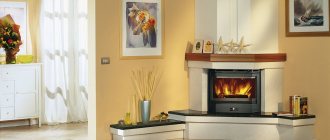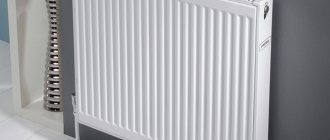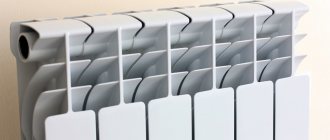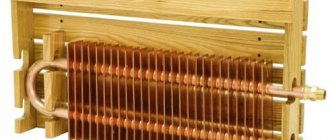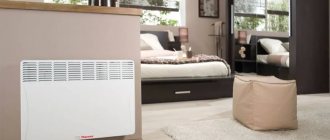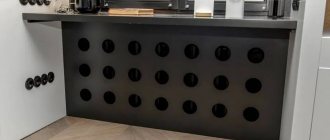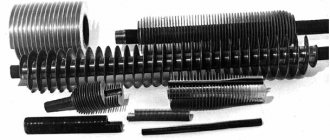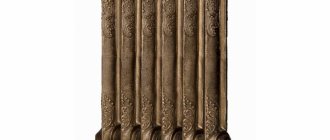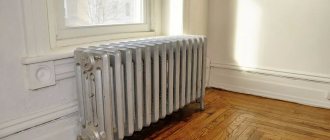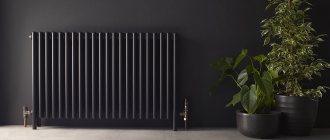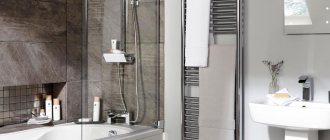Heating radiators are part of any heating system: both central and autonomous. They are responsible for the quality of heating of a house or apartment. Knowing the design features and characteristics of radiators, you can choose the right one that is most suitable for the conditions of an apartment or private house.
Parameters that will help you both correctly calculate the number of radiators for efficient heating and choose the optimal one:
- Water pressure in the system and its permissible limits for the battery.
- Features of installation and operation of heating devices.
- Ability to withstand water hammer.
- Maximum permissible coolant temperature.
- Value for money.
Types of radiators
Heating radiators, depending on the material of manufacture, come in the following types:
- Radiators made of cast iron.
- Radiators made of steel.
- Radiators made of aluminum.
- Bimetallic radiators.
Each of these types has its own pros and cons. And you can decide what is suitable and what is not, knowing all the pros and cons.
Do-it-yourself installation of a plasterboard box
In order to close the battery, you need to measure it, and then buy metal profiles and other additional products.
- What materials are needed: 12 mm plasterboard sheet, metal profiles 27x28 and 60x27, self-tapping screws for plasterboard and metal, dowel-nails 6x40 in size, construction sickle, perforated corners.
- Tools: screwdriver, hammer drill, metal scissors, stationery knife, stapler, pencil, tape measure, building level.
Attention, for the construction of a plasterboard box there is an important requirement: the window sill must extend beyond the radiator by at least 3 centimeters.
Work order:
- Installation of the frame. The profile should be mounted on three adjacent sides: floor, wall, window sill. Press the 27x28 metal profile to the base with your hand, drill a hole using a hammer drill in both the profile and the wall. Using a screwdriver, screw the dowel-nail into the hole. At the bottom of the window sill, a 27x28 metal profile is mounted on self-tapping screws; the length of the screws should not be greater than the thickness of the window sill. Next, you can install jumpers made of metal profile 60x27.
- Selecting the grid size. This hole must be made slightly smaller than the grid size. You can focus on three recommended sizes: 60x120, 60x90 or 60x60.
- Installation of drywall. Plasterboard sheets can be cut with a utility knife. Screw it in with a screwdriver.
- Installation of corners. They must be secured at the corners with a construction stapler, or attached to gypsum plaster. Serpyanka should be applied to all seams of the plasterboard box and covered with plaster. Before painting or wallpapering, the plasterboard box must be puttied, sanded and coated with primer.
Cast iron radiators
Cast iron radiators are familiar from Soviet times. Most often they were used as radiators for apartments. The advantages of such batteries are as follows:
Made of durable cast iron material that can withstand pressure of 25-30 atmospheres. This is a large pressure reserve, since the working pressure in central heating is about 16 atmospheres.
Cast iron has good thermal conductivity: it heats up slowly and also cools down slowly. After the coolant temperature decreases, they will remain warm for some time.
Durability and reliability of cast iron radiators. The service life of cast iron radiators is up to 40 years. They are not picky about the quality of water in the system, since the thickness of the cast iron does not allow corrosion to develop.
Low price of this type of heating radiators.
The disadvantages include the following:
The heavy weight of cast iron radiators makes them inconvenient for transportation and installation. Bulky brackets are required for wall mounting.
In order for such radiators to fit beautifully into the interior of the room, they are covered with protective grilles. Thus making them more aesthetic.
With prolonged interaction with water, plaque forms inside. It gradually reduces the diameter of the radiator pipe and, accordingly, the water flow will be less and the heat transfer will also be less.
Hide with drywall
Separately, I would like to talk about how you can hide batteries using drywall. It’s worth noting right away that the material has its drawbacks, but plasterboard construction is still very popular for repairs.
- The material is environmentally friendly and is not subject to combustion.
- You can find several varieties of this material on the market.
- This camouflage option is budget-friendly, and installation can be carried out in different ways, in a way that is convenient for you.
- Also, it is drywall that will allow the apartment owner to come up with any design, which will help not only to cover the pipes and radiator, but also to make additional decorative elements.
The downside is that drywall is afraid of external influences; if you do it carelessly, it is quite easy to break or pierce it. And if a breakdown or leak occurs, the entire finish will have to be replaced again, but this material is cheap.
Bimetallic radiators
Such radiators are considered the best radiators for heating today. They are optimally suited for use in apartment buildings with central heating.
Manufacturers have tried their best and combined all the advantages of aluminum and steel radiators in one product. Structurally, they consist of a steel pipeline and aluminum ribs.
These batteries have the most advantages, such as:
Resistant to water hammer and high operating pressure. The maximum permissible pressure is up to 40 - 50 atmospheres. High and fast heat transfer due to the aluminum component in the design.
Low sensitivity to the quality of the coolant used in central heating systems. Light weight and easy to install. The service life of such radiators is about 50 years.
Possibility of assembling the required number of sections for sectional radiators.
But still, bimetallic radiators have one drawback, namely their high cost. But this pays off with a long and high-quality service life of the radiators.
Based on this review of characteristics, the following main points can be highlighted:
For apartment buildings with a centralized heating system, the best option for choosing batteries would be cast iron and bimetallic.
For owners of private houses with autonomous heating, the best choice would be aluminum and steel batteries.
Before purchasing new batteries, always pay attention to the connection diagram (side, bottom, top or universal) of radiators to the system. It is preferable that the new ones have a similar design.
Battery classification
Modern manufacturers offer owners of private houses, apartments and offices a variety of radiator models that differ in shape, material, size and style.
Principles of battery classifications:
- Purpose for specific rooms: hallway, bedroom, nursery, bathroom, kitchen.
- Installation location: under panoramic or regular windows.
- Installation method: baseboard, floor or wall.
- Shape: in the form of panels, benches or partitions, flat and ribbed.
- Size: narrow and tall.
- Material: steel, cast iron, aluminum.
- Style: retro, modern.
The most effective heating method is the use of convector radiators. They can be floor-mounted, wall-mounted or in-floor. Most often they are used in rooms where panoramic windows are installed.
Convectors built into the floor can be well camouflaged thanks to the wide color range of decorative grilles. Products can imitate the structure of natural wood. Convectors are equipped with fans to provide greater power. They are used for heating utility rooms (garages, boiler rooms), where aesthetic and hygienic requirements are lower than in residential ones.
Heating devices also include heated towel rails, which also provide heating. Electric models operate in a closed system. There are also devices operating in the DHW circuit. Both of them can be designer.
Photos of heating radiators
Examples in different interior styles
Modern style
For a modern style or a high-tech and minimalist style, any material made of wood, glass (glass panels) or metal is suitable.
Classic style
It is recommended to use natural materials; it is better to opt for a wooden lattice.
Provence
Wood also loves styles such as Provence, country, chalet and eco-style.
Scandinavian
Wooden grilles in light colors will look appropriate in the Scandinavian style.
Loft
In the loft style, old radiators and pipes are most often not covered; they are left on display or replaced with interesting design options.
Installation work
The batteries are installed under the window, which is explained by compensation for heat when street air enters through the window opening.
When installing, be sure to consider the following criteria:
- The distance from the wall is 2 centimeters.
- From the floor - 12 cm.
- From the window sill - 10 cm.
The parameters presented are not a strict rule, but only recommendations.
Now let's look at the instructions for replacing radiators.
